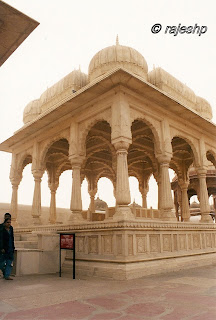On the way to Bikaner from Mandwa, we had our lunch at the road side Dhaba. We reached Bikaner around 3:30 in the afternoon.
Binaker’s history dates back to 1488 A.D, when a Rathore Prince, Rao Bikaji, established his kingdom here. Bikaji choose a barren wilderness called ‘Jangladesh’ and transformed it to an impressive city, called Bikaner after the founder’ name. More popularly called the camel country, the city is renowned for the best riding camels in the world.
The wells of Bikaner: an important source of water is other attractions of the city. These are built on high plinths with slender minareted towers on each of the four corners and can be noticed even from a distance. (Click on all the images for bigger picture)
The major attractions here are:Junagarh Fort
 Junagarh Fort was constructed between 1588 and 1593 by Raja Rai Singh, a general in the army of Mughal emperor Akhbar. , with embellishments in the form of palaces and luxurious suites added by subsequent
Junagarh Fort was constructed between 1588 and 1593 by Raja Rai Singh, a general in the army of Mughal emperor Akhbar. , with embellishments in the form of palaces and luxurious suites added by subsequent
Maharajas. This fort has a 986m-long wall with 37 bastions, a moat and two entrances.
Despite that fact Junagarh doesn't command hilltop position, as do some of the Rajasthan’s other grand forts, it is no less imposing and a credit to its planners and architects has never been conquered.
The Surajpol or the 'Sun Gate' is the main entrance. The palaces within the fort are on the southern side and make a picturesque ensemble of towers, courtyards, balconies and windows. A major feature of fort and palaces is the superb quality of stone carving. Bijai Mahal Palace is yet another exquisite palace situated inside the fort that’s worth visiting while here, that has excellent paintings and tile work.
Bijai Mahal Palace is yet another exquisite palace situated inside the fort that’s worth visiting while here, that has excellent paintings and tile work.
Anup Mahal Palace Intricate golden pen work decorates this building and is worth seeing while visiting the fort.
Durga Niwas of the fort is a beautiful courtyard with excellent paintings and tile-work worth seeing.
Chandra Mahal Palace or Moon Palace is a beautiful puja (worship) room covered with remarkable frescoes of Hindu gods and goddesses.
Diwan-e-Khas or Hall of Special Audience, with intricately carved stonework so fine that it seems as though it is carved out of wood. Worth seeing is a beautiful window in Blue Dutch tiles and a pair of golden gates which lie, behind iron bars (for security). The place is located within the fort and shouldn’t be missed.
Ganga Mahal Palace added to the fort by Maharaja Gailga Singh, now houses the Fort Museum and contains a fine collection of antique Rajput, weaponry, jade handle daggers, camel hide shields, inlaid handguns and camel guns, gold and silver howdahs, jhulas, kis and a first-world war biplane. Other important objects include a pair of drums belonging to jamblioji, the saint who predicted the foundation of the dynasty by Rao Bika for 450 years.
Apart from the fort and the palaces within in, Bikaner has quite a many more attractions.
P.S: December is the month when lot of tourists land in Rajasthan. So if you really want all the arrangements to be done properly this has to be done before October end.
 Eight Kilometers east of Bikaner, this is the site of royal chatris of many of the Bika dynasty rulers. The royal crematorium has several exquisite cenotaphs (Chatris). Each Chatri is dedicated to the memory of rulers of Bikaji dynasty and is situated on the exact place where they were cremated.
Eight Kilometers east of Bikaner, this is the site of royal chatris of many of the Bika dynasty rulers. The royal crematorium has several exquisite cenotaphs (Chatris). Each Chatri is dedicated to the memory of rulers of Bikaji dynasty and is situated on the exact place where they were cremated. 

